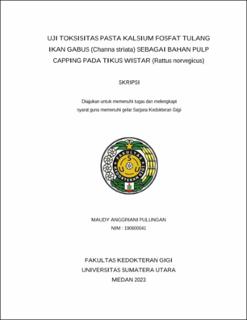| dc.description.abstract | Direct pulp capping requires a material that can stimulate the formation of a
dentinal bridge. The material that is widely used in direct pulp capping treatment is
calcium hydroxide but in the long term calcium hydroxide does not give good results to
dentin, does not consistently support odontoblast differentiation and has been shown to
be cytotoxic in cell culture. Calcium phosphate paste from snakehead fish bone at a
concentration of 75% has been shown to be used as an alternative material for the pulp
capping, however, safety needs to be ensured. This study aims to determine the results of
the toxicity tests and the safe dosage of calcium phosphate paste of snakehead fish bone
as a material for pulp capping in wistar rats.
This study was an experimental post test only control group design in vivo. This
study used 20 rats divided into 4 treatment groups, namely the negative control group, the
0,1, 0,2 and 0,5 gram dose groups. The paste applied to the gingival sulcus was observed
for 3 days to observe the effects of erythema and edema on the gingiva and histological
appearance with 100x and 400x magnification. The body weight changes and number of
inflammatory cell infiltrates along blood vessels were analyzed using Oneway- ANOVA
followed by Post Hoc LSD and while the erythema and edema scores were looked at to
determine the value of irritation index. Statistical test results revealed that there was no
significant difference in changes in the body weight of the wistar rats, for the types of
erythema and edema, the number of inflammatory cells infiltrated along blood vessels in
each treatment group (p>0.05). In addition, the irritation index obtained was 0 with a nonirritating
classification at doses of 0,1, 0,2 and 0,5 grams. It was concluded in this study that calcium phosphate bone snakehead paste at a
concentration of 75% was not toxic and safe to use at high doses of 0.5 grams. | en_US |

